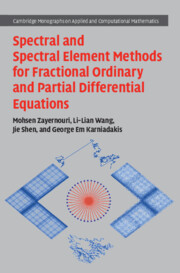14862 results

Spectral and Spectral Element Methods for Fractional Ordinary and Partial Differential Equations
- Coming soon
-
- Expected online publication date:
- September 2024
- Print publication:
- 30 September 2024
-
- Book
- Export citation

Negotiating Legality
- Chinese Companies in the US Legal System
- Coming soon
-
- Expected online publication date:
- June 2024
- Print publication:
- 30 June 2024
-
- Book
- Export citation
Assessing associations between individual-level social determinants of health and COVID-19 hospitalizations: investigating racial/ethnic disparities among people living with HIV in the U.S. National COVID Cohort Collaborative (N3C)
-
- Journal:
- Journal of Clinical and Translational Science / Accepted manuscript
- Published online by Cambridge University Press:
- 21 May 2024, pp. 1-43
-
- Article
-
- You have access
- Open access
- Export citation
Perspectives for extraordinary elastic-wave control in non-Hermitian meta-structures
-
- Journal:
- Programmable Materials / Volume 2 / 2024
- Published online by Cambridge University Press:
- 20 May 2024, e4
-
- Article
-
- You have access
- Open access
- HTML
- Export citation
The long-term spatio-temporal trends in burden and attributable risk factors of major depressive disorder at global, regional and national levels during 1990–2019: a systematic analysis for GBD 2019
-
- Journal:
- Epidemiology and Psychiatric Sciences / Volume 33 / 2024
- Published online by Cambridge University Press:
- 20 May 2024, e28
-
- Article
-
- You have access
- Open access
- HTML
- Export citation
A variational principle of amenable random metric mean dimensions
- Part of
-
- Journal:
- Proceedings of the Edinburgh Mathematical Society , First View
- Published online by Cambridge University Press:
- 16 May 2024, pp. 1-24
-
- Article
- Export citation
Binary pattern retrieval with Kuramoto-type oscillators via a least orthogonal lift of three patterns
- Part of
-
- Journal:
- European Journal of Applied Mathematics , First View
- Published online by Cambridge University Press:
- 16 May 2024, pp. 1-16
-
- Article
-
- You have access
- Open access
- HTML
- Export citation
ABSORPTION AND DISTRIBUTION OF ULTRATRACE EXOGENOUS 14C UREA IN RATS
-
- Journal:
- Radiocarbon , First View
- Published online by Cambridge University Press:
- 16 May 2024, pp. 1-10
-
- Article
- Export citation
A systematic review of the cost and cost-effectiveness of immunoglobulin treatment in patients with hematological malignancies
-
- Journal:
- International Journal of Technology Assessment in Health Care / Accepted manuscript
- Published online by Cambridge University Press:
- 16 May 2024, pp. 1-23
-
- Article
-
- You have access
- Open access
- Export citation
Unifying constitutive law of vibroconvective turbulence in microgravity
-
- Journal:
- Journal of Fluid Mechanics / Volume 987 / 25 May 2024
- Published online by Cambridge University Press:
- 16 May 2024, A14
-
- Article
- Export citation
A 1179-yr (417–1595 CE) tree-ring oxygen isotope chronology for northern Japan validated using the 774–775 CE radiocarbon spike
-
- Journal:
- Radiocarbon , First View
- Published online by Cambridge University Press:
- 16 May 2024, pp. 1-13
-
- Article
-
- You have access
- Open access
- HTML
- Export citation
Considering climate change impact on the global potential geographical distribution of the invasive Argentine ant and little fire ant
-
- Journal:
- Bulletin of Entomological Research , First View
- Published online by Cambridge University Press:
- 16 May 2024, pp. 1-12
-
- Article
- Export citation
Spatial-temporal distribution characteristics of pulmonary tuberculosis in eastern China from 2011 to 2021
-
- Journal:
- Epidemiology & Infection / Accepted manuscript
- Published online by Cambridge University Press:
- 15 May 2024, pp. 1-25
-
- Article
-
- You have access
- Open access
- Export citation
Asymptotic profiles of a nonlocal dispersal SIS epidemic model with saturated incidence
- Part of
-
- Journal:
- Proceedings of the Royal Society of Edinburgh. Section A: Mathematics , First View
- Published online by Cambridge University Press:
- 14 May 2024, pp. 1-33
-
- Article
- Export citation
Flat model structures and Gorenstein objects in functor categories
- Part of
-
- Journal:
- Proceedings of the Royal Society of Edinburgh. Section A: Mathematics , First View
- Published online by Cambridge University Press:
- 14 May 2024, pp. 1-21
-
- Article
- Export citation
SUMMABILITY AND ASYMPTOTICS OF POSITIVE SOLUTIONS OF AN EQUATION OF WOLFF TYPE
- Part of
-
- Journal:
- Bulletin of the Australian Mathematical Society , First View
- Published online by Cambridge University Press:
- 14 May 2024, pp. 1-10
-
- Article
- Export citation
Southbound transmission of metallurgy: new excavations at Jicha in the Hengduan Mountains, Yunnan
-
- Journal:
- Antiquity , First View
- Published online by Cambridge University Press:
- 13 May 2024, pp. 1-8
-
- Article
-
- You have access
- HTML
- Export citation
Shared and distinct electroencephalogram microstate abnormalities across schizophrenia, bipolar disorder, and depression
-
- Journal:
- Psychological Medicine , First View
- Published online by Cambridge University Press:
- 13 May 2024, pp. 1-8
-
- Article
- Export citation
Sociome Data Commons: A scalable and sustainable platform for investigating the full social context and determinants of health – ERRATUM
-
- Journal:
- Journal of Clinical and Translational Science / Volume 8 / Issue 1 / 2024
- Published online by Cambridge University Press:
- 13 May 2024, e82
-
- Article
-
- You have access
- Open access
- HTML
- Export citation



























